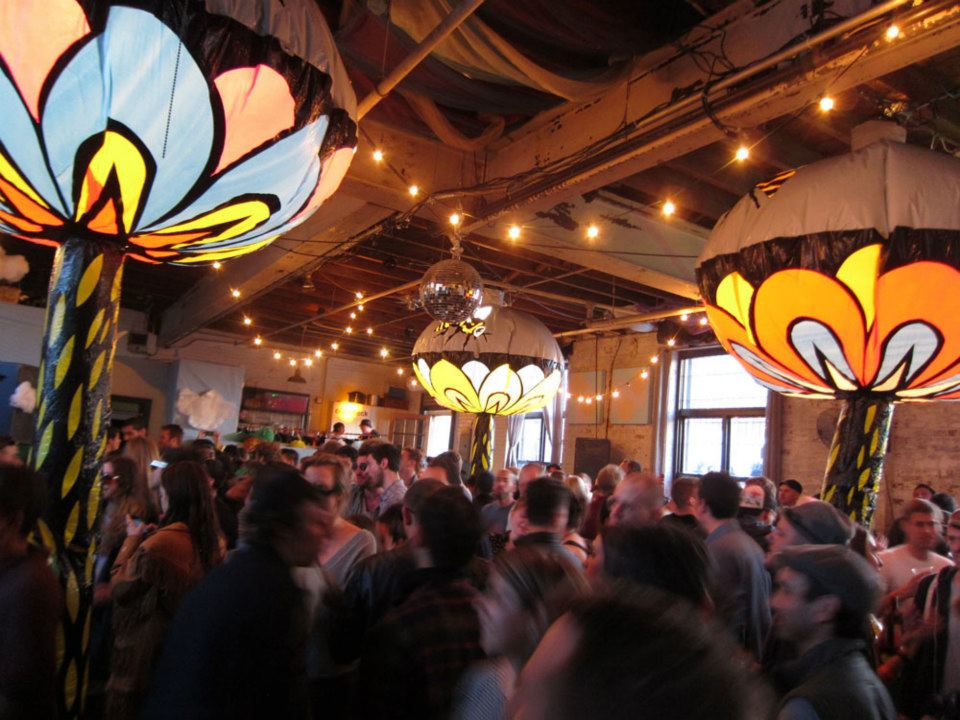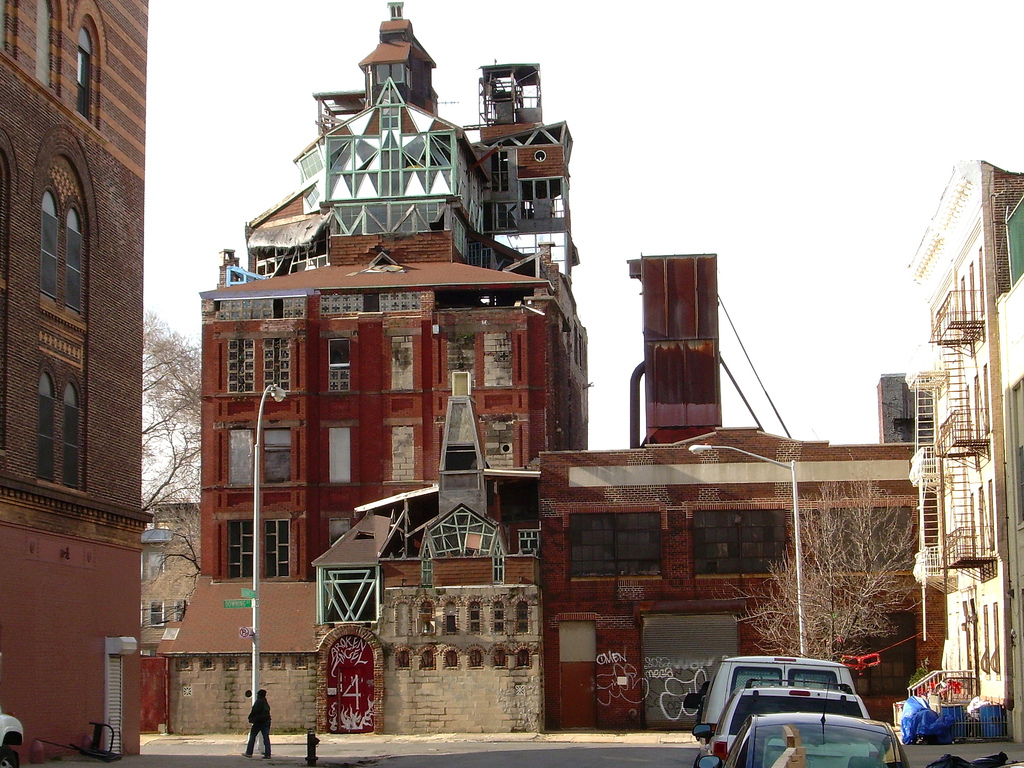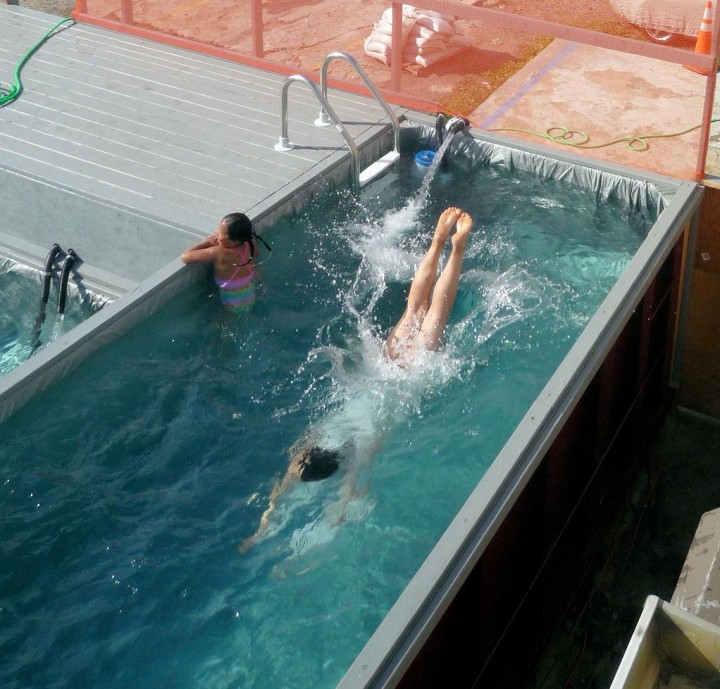12-turn-13
space type: parties, events | neighborhood: clinton hill | active since: 1998 | links: website, facebook
Art party space 12-turn-13 sits in a huge industrial building dating back to the 1930s, one of only two remaining structures from the MH Renken Dairy complex (preservationists are working to designate the other as a historic landmark). For the last sixteen years—an incredible lifespan in today’s deliriously shifting Brooklyn underground—this beautiful loft has hosted all manner of DJs, gallery shows, and complex performance events, from Wolf + Lamb and Mister Saturday Night dance parties to exotic honey tastings and elaborately themed fêtes.
Read on for plenty of reminiscences and fantastic stories from owner Steve R. about sixteen years of underground Brooklyn brilliance.
[n.b.: this interview took place in September 2013]
brooklyn spaces: This space is just gorgeous. What was it like when you got it?
Steve: Oh, it was an absolute sty. There were these huge hinged industrial windows that weighed about fifty pounds, they had bars on the outside and the inside. There were strips of fluorescent lights hanging from the dropped ceilings, which were curling at the edges from water damage. There were all sorts of wire conduits everywhere, and there was a concrete bunker in the corner that functioned as a bathroom—it consisted of a toilet, about enough space for a toilet paper roll, and on the outside, literally hanging off its pipe, a sink that didn’t work. That was it.
brooklyn spaces: So it was love at first sight?
Steve: Well, I’d looked at about sixty different places, from Sunset Park to Greenpoint—leaving out Williamsburg, because I knew I didn’t want to go there.
brooklyn spaces: Even in 1998 you didn’t want to go to Williamsburg?
Steve: Well, I was living in the East Village at the time, and an Urban Outfitters had just moved in across the street from me. I knew what was going to happen in Williamsburg, and I just couldn’t do that again. Anyway, I had a car at the time, so I drove here, and when I walked in, this place was so disgusting, but I could see the beams, the wood floors, the perfect lighting, I knew it had the bones. So I immediately said, “Yes, I’ll take it!” And then I drove back to the East Village and thought, “Oh god, is there a subway? Is there any food?” I had no idea. So I had to come back and walk the neighborhood. Luckily there was a post office, a supermarket, a few amenities. So yes, love at first sight, and then a lot of work. We ripped out the drop ceiling and exposed all these beams—that took about nine months on a twelve-foot ladder, scraping it all by hand with a little brush. And then carpenters, electricians, plumbers; we basically built everything from scratch.
brooklyn spaces: And the goal was always to make a living space where you could throw parties?
Steve: Yes. My East Village apartment was 600 square feet, and I had parties there for years. My scene was DJs and downtown artists, performers, and fashion people. We did First Friday salons every month, where people would come over and share what they did, creatively. It grew to the point where we had a keg in the bathtub and people lined up and down the stairs smoking cigarettes until 4 o’clock in the morning, and I just realized my neighbors hated me and I had to move.
brooklyn spaces: You had no resistance to coming to Brooklyn?
Steve: There was only Brooklyn. Where else could we go?
brooklyn spaces: What about your guests—was there resistance for them to come to Brooklyn?
Steve: Oh god, yes. This is back in the day when we had to actually print invitations and handwrite the addresses and put them in the mail. People didn’t even know about the G; back then we called it the Ghost Train. One friend came out for a salon here and didn’t have my phone number; he was banging on the door but we didn’t hear him, and he went back home and that was the end of our friendship. He was so upset about how far he’d had to come! Nowadays of course it’s no big deal, but then? Yeah, it was tough.
brooklyn spaces: What was the neighborhood like?
Steve: Well, Myrtle Avenue was called Murder Ave. There was a double homicide right up the block, there was a brothel across the street; once they threw a television out a fourth-floor window—what a spectacular crash. There were no gays, not many white kids. But what I loved about it was that it was Brooklyn, it felt so real to me. And I knew all my neighbors, they would all come to my parties. Now everybody looks alike and I hardly know any of them.
brooklyn spaces: How has it been, watching that change?
Steve: Well, I can actually eat in my neighborhood now. I can buy coconut ice cream at 4 in the morning, and there are boutiques and a yoga studio; but now I have to be concerned about how much noise I make. So it’s not the same but the neighborhood has retained a lot of its character, and I think it’s changing with some integrity. But we’ll see how it goes.
brooklyn spaces: Let’s talk about the parties. Tell me about some great ones or awful ones or really memorable ones.
Steve: Oh my, sixteen years. Let’s see. In probably 1999 we threw a series of parties called “b_list.” The price to get in was $3—the graffiti tag “$3 too much” is still in my hallway. We had breakdancers spinning on cardboard boxes, go-go dancers, the DJ atop the booth with his pants around his ankles; people were having sex in the bathroom, sex in the water-heater closet, sex in the corner—it was crazy. Someone shat on my couch in the supposedly locked storage area.
brooklyn spaces: Wow. Were all the parties that intense?
Steve: No, no, that was something of an anomaly. When I moved in here it was to make a playground for a variety of artists, and every party had basically two criteria: it had to be multi-disciplinary, and it had to change the space, so that every time you walked in here you went “Ooh, it’s totally different!” We did a series of “Art Inspired By Nature” parties that were very involved: from 6 to 9 it was a proper art gallery, from 9 to 11 there were performances, and then the lights would go down, the DJs would start, and, you know, my parents and all the neighborhood kids would vacate and it would turn into a real party. Those parties were so much effort! First we curated about 30 artists around a nature theme, and then I found an environmental nonprofit partner—for one about water, we partnered with Riverkeeper and they did a lecture for us on the New York Watershed; we also went to the Coney Island Aquarium and got a behind-the-scenes tour of feeding the sharks and propagating jellyfish. For another, about air, we partnered with Earthpledge. So it was about six months of work and planning leading up to a one-night event, and it was like BOOM, crescendo! And then massive depression afterward. It became very difficult to maintain that momentum.
brooklyn spaces: How did you keep from totally wearing yourself out?
Steve: Well, around 2005 I met the Wolf + Lamb guys and started throwing parties with them, which was much easier: all I had to do was set up and clean the space. They had a following, so they’d promote to their people, I’d promote to my people, and everyone would come. There was suddenly this thing called email, which made it all so much easier! So I’ve been doing mostly DJ parties ever since then. We’ve been doing the Mister Saturday Night parties for about five years now, with some Mister Sunday parties in the winter months. They’re the most magical parties, full of a diverse group of people, and even children. We really deck out the space with fun décor and art installations; we’ve been partnering with Jeffrey Ralston, who does amazing inflatables that make everyone smile.
brooklyn spaces: So DJ parties became your main focus.
Steve: Yes, but I do still host smaller, more intimate and creative salons. We’ve had supper clubs and wine tastings and salsa dancing lessons and a jazz concert. Oh, and one of my favorite recent parties was for my birthday, a Bee-Day Party, because I’m now a beekeeper. We had flowers everywhere, there was a honey tasting, we had a little photo booth with Astroturf, a real log, a flower-ringed arbor, sky, clouds, and a kite. Jeff did these gigantic nine-foot inflatable flowers. It was wonderful.
brooklyn spaces: Tell me about one more really memorable party, where everything just worked perfectly.
Steve: A few years ago we did one called “Dante’s Inferno” in collaboration with the theatre collective Augenblick. It started in the city and went through the Nine Circles of Hell on the way here. The first and second were in Union Square, the third was on the L train platform, the fourth and fifth were in the Lorimer station, the sixth was on the G train at the Classon stop, and then on down the hill. When people approached 12-turn-13, we had all these performers out on the street: fire throwers and twirlers and a nine-foot monster. And then you came inside and the entire space was decorated to be Hell. People walked in through a green screen, and their images were projected in flames elsewhere in the space. It was incredible.
brooklyn spaces: Having come from the East Village and been here for so long, what do you think is the influence of Brooklyn on 12-turn-13—or the influence of 12-turn-13 on Brooklyn?
Steve: I came to Brooklyn at the right time. I think at this point, finding a space like this, it’s kind of too late unless you have a lot of money or you’re venturing much farther out. But I think there are still pockets all around. I have friends in the Rockaways who bought the Playland Motel, which is an amazing space, and I know there’s the whole industrial complex in Sunset Park that’s going to explode. There’s still that pioneering spirit, and there’s still space if you look for it. During the Red Bull Music Academy, Justin [Carter, of Mister Saturday Night] and I went out to Knockdown Center, and walking into that courtyard, seeing that massive building, I felt like it was 1996 again, this feeling of discovering something new and different and grand and ambitious and magnificent.
brooklyn spaces: Knockdown Center is one of my absolute favorite new spaces.
Steve: Architecturally, it’s astounding. It reminded me of the Lunatarium, this incredible space that was in Dumbo in the 2000s [ed note: check out Jeff Stark’s great piece on the closing of the Lunatarium], or the Fake Shop in Williamsburg, which was a huge warehouse where they had amazing inflatable installations and dark sensory-deprived crawl-space mazes you went through on your hands and knees. Knockdown Center for me was like, “Wow. It’s still happening.” There are always people who want to have an adventure, that craving for discovery. 12-turn-13 is the same, it’s a destination. You need to want to come here, but we’re going to throw such a good party that it will be worth the journey. At least, we hope it will.
***
Like this? Read about more underground party spaces: Rubulad, Gemini & Scorpio, Red Lotus Room, The Lab, Egg & Dart Club, Gowanus Ballroom, Newsonic











































































